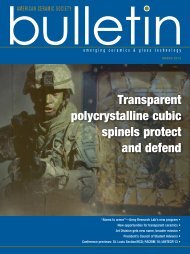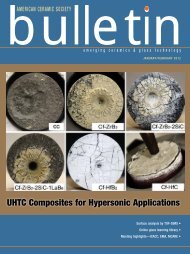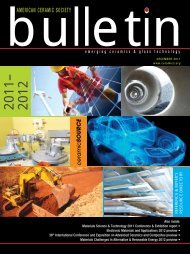American Ceramic Society Bulletin
American Ceramic Society Bulletin
American Ceramic Society Bulletin
Create successful ePaper yourself
Turn your PDF publications into a flip-book with our unique Google optimized e-Paper software.
‘Cotton candy’ that heals?<br />
Venous stasis creates<br />
hard-to-heal wounds<br />
The history of Taylor’s patient’s<br />
wound is typical for a diabetic. “It<br />
started out as a bruise on her shin,” she<br />
says. “It was the kind of thing where<br />
the patient said, ‘Ow. It really hurt a<br />
lot, but I am glad I didn’t break my leg.’<br />
It took awhile before she or anyone<br />
else realized there was a more extensive<br />
and deep-tissue injury there. In fact, it<br />
was a deep hematoma that eventually<br />
opened. It looked like a big number ‘6’<br />
and if it weren’t for the debris in the<br />
wound, I would have seen bone.”<br />
Taylor explains that diabetics and<br />
often the elderly develop troublesome<br />
and dangerous extremity wounds, called<br />
venous stasis ulcers. Aging diseases<br />
and diabetes wreak havoc on lower leg<br />
blood vessels. Blood and other fluids<br />
pool, and the vessels and their valves<br />
get damaged to the point where they<br />
don’t function effectively.<br />
And, unfortunately, that’s only the<br />
beginning. If the fluid stays in the<br />
vessels, big differences in the pressure<br />
gradient between inside and outside the<br />
vessels form, and they start leaking fluid<br />
into other tissues. The fluid looks for a<br />
way outside the body and stretches skin<br />
tissue to form thin spots that can spontaneously<br />
crack and start weeping. A<br />
bump, even a small one, can accelerate<br />
the weeping process. A big bruise, such<br />
as the one her patient suffered, can trigger<br />
a large amount of weeping.<br />
In these situations, the worst is yet<br />
to come, because the weeping fluids<br />
initiate the wound-forming stage. “This<br />
wound fluid is something of a cleaner,”<br />
says Taylor. “It contains lots of enzymes.<br />
But, the fluid’s enzymatic cleaning<br />
action eats away at the tissue at the<br />
surface of the wound. If the patient<br />
has a bandage or something over it, or<br />
even clothing, the fluid is held next<br />
to the skin and it starts to erode away<br />
the tissue. With the fluids from venous<br />
stasis, you get a wound that goes on and<br />
on because it won’t quit weeping long<br />
enough for it to heal.”<br />
The wounds are annoying and painful,<br />
but a big danger arises because a<br />
hole in the skin is an invitation to bacteria<br />
and infection. When the elderly<br />
and diabetics don’t have good<br />
circulation the chances of getting<br />
an infection in their lower<br />
extremities are enhanced. “You<br />
have bone that is close to the<br />
surface of the skin. The marrow<br />
in the bone produces your<br />
red blood cells, so suddenly you<br />
have a situation where an infection<br />
could become systemic” and<br />
potentially fatal, says Taylor.<br />
Thus, nonhealing wounds<br />
and the infections that often<br />
accompany them are a big concern.<br />
And, to counter stagnant<br />
wounds and infections, limb<br />
amputation is often the only<br />
recourse. So, it’s no wonder<br />
that patients with hard-to-heal<br />
wounds often seek out specialized<br />
wound-care treatments.<br />
Borate-based<br />
bioactive glasses<br />
In 2010, Steve Jung, along<br />
with the father and son team<br />
of Delbert and Ted Day already<br />
knew a lot about bioactive glasses.<br />
Del Day founded Mo-Sci<br />
Corp., a company that already<br />
made glass products for biological<br />
uses. Ted recently has taken over<br />
as CEO and president of the enterprise.<br />
Jung, who looks to be in his late 20s,<br />
got to know the older Day, a renowned<br />
professor, at the Missouri University of<br />
Science and Technology. Jung earned<br />
his bachelor’s and master’s degrees in<br />
ceramic engineering at Missouri S&T<br />
and eventually a Ph.D. in materials science<br />
from the school.<br />
Jung began working for Del Day in<br />
2001, and in his Ph.D. work and collaborations<br />
with Day he became interested<br />
in bioactive glasses, especially borate<br />
glasses. “For decades, bioactive glasses<br />
have been known to bond well with<br />
hard and soft tissues,” says Jung. “Much<br />
of this knowledge has been directed<br />
toward the regeneration of bone. But a<br />
lot of us also have been thinking about<br />
soft-tissue regeneration.”<br />
Jung acknowledges that most of the<br />
gains in bioactive glasses have been<br />
founded on silicate-based materials, but<br />
he says he was intrigued by some things<br />
The initial stage of wound healing requires the<br />
formation of a fibrin clot. The top SEM image<br />
shows a fibrin clot composed of nanosized<br />
cross-linked fibrin fibers that initiate the healing<br />
process. The fibers shown below are made of the<br />
bioactive borate glass. The fiber diameter and<br />
overall microstructure is similar to the fibrin clot,<br />
and provides the wound with an artificial starting<br />
point.<br />
he learned about borate glasses.<br />
“An in-vitro study of lithium borate<br />
glasses showed it to have beneficial<br />
antibacterial effects against harmful<br />
bacteria, such as e.coli, salmonella and<br />
staph,” says Jung. “Apparently the bacteria<br />
are killed as the lithium alkali is<br />
released into the immediate surrounding<br />
area of the glass, which creates a<br />
local spike in the pH.”<br />
Jung says he, Del Day and other collaborators<br />
compared the rates of how<br />
silicate-based and borate-based bioactive<br />
glasses reacted to body fluids. “In certain<br />
in-vitro experiments,” he reports, “we<br />
determined that bioactive glasses containing<br />
boron as the glass former react<br />
to simulated body fluids up to five times<br />
faster than silicate glasses do.”<br />
Jung also says they were curious<br />
about a particular bioactive borate<br />
glass – 13-93B3 glass (53B 2 O 3 , 20CaO,<br />
12K 2 O, 6Na 2 O, 5MgO, 4P 2 O 5 (in<br />
weight percent)) – because of its calcium<br />
content. He notes, “Investigators<br />
26 <strong>American</strong> <strong>Ceramic</strong> <strong>Society</strong> <strong>Bulletin</strong>, Vol. 90, No. 4<br />
(Credit: Jung et al)






